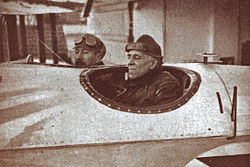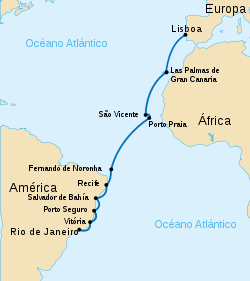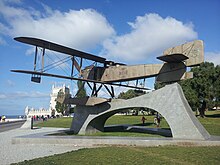
Fernando de Noronha is an archipelago in the Atlantic Ocean, part of the State of Pernambuco, Brazil, and located 354 km off the Brazilian coast. It consists of 21 islands and islets, extending over an area of 26 km2 (10 sq mi). Only the eponymous main island is inhabited; it has an area of 18.4 km2 (7.1 sq mi) and a population estimated at 3,101 in 2020. While the archipelago is relatively low-lying, there are parts stretching above 100 m (328 ft) in elevation.
Transatlantic crossings are passages of passengers and cargo across the Atlantic Ocean between Europe or Africa and the Americas. The majority of passenger traffic is across the North Atlantic between Western Europe and North America. Centuries after the dwindling of sporadic Viking trade with Markland, a regular and lasting transatlantic trade route was established in 1566 with the Spanish West Indies fleets, following the voyages of Christopher Columbus.

The Dornier Do J Wal ("whale") is a twin-engine German flying boat of the 1920s designed by Dornier Flugzeugwerke. The Do J was designated the Do 16 by the Reich Air Ministry (RLM) under its aircraft designation system of 1933.
A transatlantic flight is the flight of an aircraft across the Atlantic Ocean from Europe, Africa, South Asia, or the Middle East to North America, Latin America, or vice versa. Such flights have been made by fixed-wing aircraft, airships, balloons and other aircraft.

The Fairey Aviation Company Fairey III was a family of British reconnaissance biplanes that enjoyed a very long production and service history in both landplane and seaplane variants. First flying on 14 September 1917, examples were still in use during the Second World War.

The Portuguese Navy is the naval branch of the Portuguese Armed Forces which, in cooperation and integrated with the other branches of the Portuguese military, is charged with the military defense of Portugal.
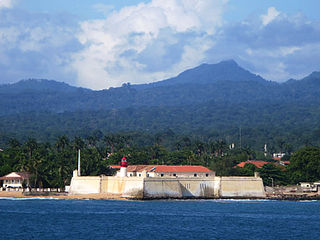
Pico de São Tomé is the highest mountain in São Tomé and Príncipe at 2,024 m (6,640 ft) elevation. It lies just west of the centre of São Tomé Island, in the Parque Natural Obô de São Tomé and in the Lembá District. The second highest point, Pico de Ana Chaves, lies about 3 km to its south east. The town Santa Catarina is 8 km to the west.

The Saint Peter and Saint Paul Archipelago is a group of 15 small islets and rocks in the central equatorial Atlantic Ocean. It lies in the Intertropical Convergence Zone, a region of the Atlantic characterized by low average winds punctuated with local thunderstorms. It lies approximately 510 nmi from the nearest point of mainland South America ; 625 km (388 mi) northeast of the archipelago of Fernando de Noronha; 990 km (620 mi) from the city of Natal; and 1,824 km (1,133 mi) from the west coast of Africa. Administratively, the archipelago belongs to Brazil and is part of the special "state district" of Fernando de Noronha, in the state of Pernambuco, in spite of the very large distance between the two island groups and the even larger distance to the state mainland.

Manuel Maria Sarmento Rodrigues was a naval officer, colonist and professor. He was born in 1899 in Freixo de Espada à Cinta, Portugal. He attended a secondary school in Bragança and attended the University of Coimbra. He entered the Naval School and concluded the marine course in 1921.

Artur de Sacadura Freire Cabral, GCTE, known simply as Sacadura Cabral, was a Portuguese aviation pioneer. He, together with fellow aviator Gago Coutinho, conducted the first flight across the South Atlantic Ocean in 1922, and also the first using only astronomical navigation, from Lisbon, Portugal, to Rio de Janeiro, Brazil.
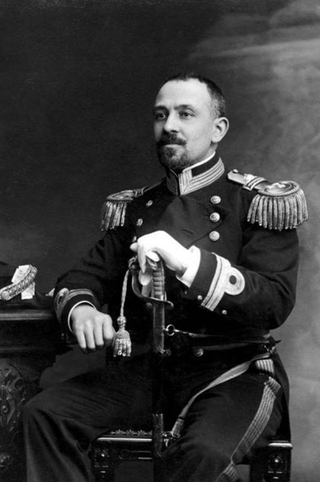
Carlos Viegas Gago Coutinho, GCTE, GCC, generally known simply as Gago Coutinho, was a Portuguese geographer, cartographer, naval officer, historian and aviator. An aviation pioneer, Gago Coutinho and Sacadura Cabral were the first to cross the South Atlantic Ocean by air, from March to June 1922, from Lisbon, Portugal, to Rio de Janeiro, Brazil.
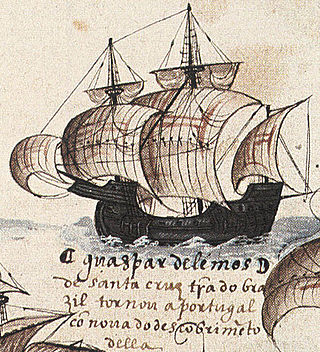
Gaspar de Lemos was a Portuguese explorer and captain of the supply ship of Pedro Álvares Cabral's fleet that arrived to Brazil. Gaspar de Lemos was sent back to Portugal with news of their discovery and was credited by the Viscount of Santarém as having discovered the Fernando de Noronha archipelago in the Atlantic Ocean.
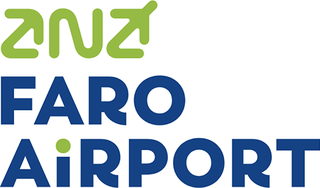
Faro Airport, officially Gago Coutinho Airport, is located four kilometres west of Faro in Portugal. The airport opened in July 1965 being the main gateway to the year-round resort region of the Algarve with nine million passengers using the facility in 2019.

Plus Ultra is a Dornier Do J flying boat which completed the first transatlantic flight between Spain and South America in January 1926 with a crew of Spanish aviators, that included: the major Ramón Franco, the captain Julio Ruiz de Alda Miqueleiz, the sub-lieutenant Juan Manuel Durán, and the mechanic Pablo Rada.
The Sport Clube Lusitânia is a sports club located in Angra do Heroísmo on the island of Terceira, in the Portuguese archipelago of the Azores.

The Portuguese Naval Aviation constituted the air component of the Portuguese Navy, from 1917 to 1957. The Portuguese Air Force maritime patrol units and the Navy's Helicopter Squadron are the present successors of the former Portuguese Naval Aviation.
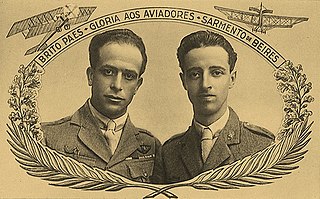
José Manuel Sarmento de Beires was a Portuguese Army officer and an aviation pioneer.

Fernando de Quintanilha e Mendonça Dias GCC, TO, ComA, GOA, GCA, MPBS, MOBS, GOI, GOIH, ECMM was a member of the Portuguese Navy, and a political and colonial administrator during the Estado Novo and Minister of the Navy from 1958 to 1968. In this role he was instrumental in the creation of the Hydrographic Institute.
The Lafay Independência was a Brazilian twin-engine, biplane aircraft, the first of its kind built in Latin America.
